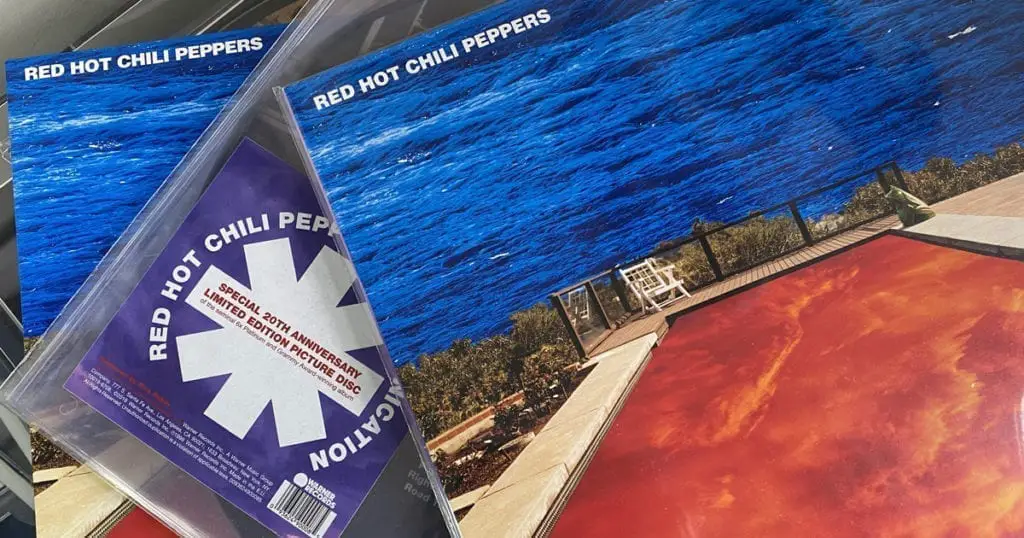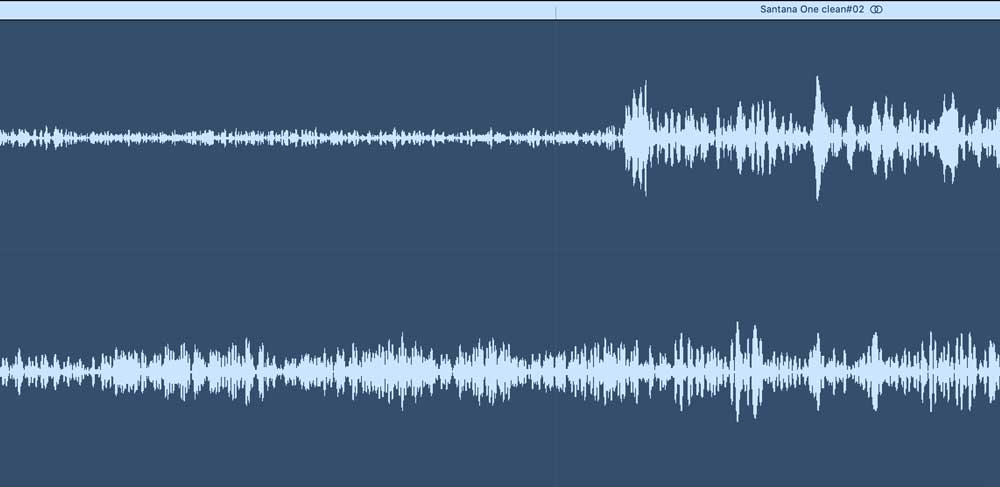Here’s why I own four copies of The Red Hot Chili Peppers Californication.
The mastering process of a vinyl record can make or break the overall sound quality. The mix engineer can get everything right, from the initial microphone technique to the final mix, but if the mastering quality is poor, the record will fall at the final hurdle.
Sadly, there are countless records out there (particularly from the late 90s and 2000s) that are the victim of poor quality mastering.
So what happened?

In short, commercial pressure over time resulted in a so-called “loudness war” where the overall volume of albums crept up over the years. The phenomenon came to a head during the 2000s, but its origins actually go back much further…
We can track the loudness war back to the release of 7″ singles played on jukeboxes in pubs, clubs, & bars. The jukebox would normally be set to a pre-defined volume by the owner, and thus if your records were mastered “hotter” than the others, it would be louder and subsequently gain more attention. So, the incentive has always been there…
Things become quite different when we enter the digital domain, as there is a maximum level “ceiling” of 0db. Once you hit this top level, you get hard digital clipping, which translates as distortion.
To raise the volume without clipping, mastering engineers use compression to reduce the difference between peak and average music levels. Over time, we’ve witnessed a sonic arms race, where record labels and producers squeeze their music onto the highest possible level, for fear of not being competitive.
But this is a vinyl website, not a music production publication, so I will let the following video sum the entire process up succinctly:
The practice of applying excess compression to boost the overall perceived volume artificially progressed exponentially throughout the 90s. By the time we reached the decade’s end, there were several notable examples where even non-audiophile listeners began to notice quality issues. Perhaps most famously, Red Hot Chili Peppers “Californication” and Metallica’s “Death Magnetic Magnetic” were among some of the worst offenders.
Both of these records suffer from extreme compression that sucks the dynamics from the music and the levels into clearly audible digital clipping.
The Red Hot Chili Peppers are a particularly good example, as their 1991 classic Blood Sugar Sex Magik stands in stark comparison. Here, the dynamics are superb, the mastering compression is mild, and in my opinion, it’s one of the best recordings to come out of the 90s.
During my music technology studies, I clearly remember my university lecturer talking about both records and how he’d gone from being a huge fan of the band in the early 90s to woefully disappointed by the release of 1999s Californication.
As the video above explains, by squashing the natural human dynamics, we remove all the light and shade that makes music interesting and exciting. Instead, we’re left with a dull, benign sound that easily fades into background wallpaper music. Without any quiet, there can be no loud.
Consumers Demand Better (And why I own Four Copies of Californication)
Since the bad old days of the late 90s and 2000s, things have eased off a little. Some balance restored in recent years, partly because the industry recognized there is a problem, but also because of changing listening habits.
Our unlikely savior is music streaming. Over recent years, subscription-based services have introduced “normalized levels” — an automated volume control that evens out levels from one track to the next.
Under such conditions, the loudness advantage (which can seem better at first) is completely removed. All tracks play at the same normalized level, and so music with “loudness war” over-the-top compression ends up sounding soft and dull next to productions where the punch and dynamics are still intact.
Vinyl, as a format, has often provided some sanctuary from the loudness war over the last couple of decades. Music that’s overcompressed doesn’t translate well to vinyl. That, and it takes considerable time and skill to master and cut a vinyl record properly. By purchasing music on vinyl, you significantly increase your chances of someone with considerable skill being behind the mastering process.
In addition to the above, vinyl records tend to attract an audiophile audience, so there is more incentive to take considerable care over the mastering process. None of this is guaranteed, of course — there are plenty of poorly mastered vinyl records on the market — but when all is said and done, the commercial incentive for labels to try harder is arguably a factor.
With that said, Californication is case-in-point. There has always been a demand to see the original 1999 release remastered. For many years, there was an MP3 copy of the supposedly “unmastered” version of the record floating around the internet. Frustrated consumers flocked to this version of the record to avoid the excessive compression and enjoy songs they loved but without the harsh and fatiguing digital distortion.
Some consumers turned to the vinyl copy in the hope of salvation but were sorely disappointed to find it was the same “squashed” mix as the original CD, just pressed to vinyl. It wasn’t until 2012 that the record finally received a proper remaster, specifically for vinyl, when Chris Bellman at Bernie Grundman Mastering was tasked with cutting the record for a 180g re-pressing.
Though not a perfect-sounding record, the 2012 copy shows a significant improvement. It’s far from the quality of production on 91s Blood Sugar Sex Magik, but it’s far easier on the ear and worth seeking out. Check out the video overview below for a comparison of each version.
Audio Comparison
As you can hear, the original master is squashed and compressed to a level of unacceptable distortion. The snare is reduced to a hard crunch rather than a crisp snap, and the symbols take on an aggressive edge that is fatiguing on the ear. Worst of all, the slide guitar solo is audibly distorted.
The 2012 cut is significantly improved but still quite compressed. There is still a lot of compression on the drums that may be from individual track compression. Once the original recording is bounced down to a stereo file for mastering, there’s really nothing a mastering engineer can do about this issue. However, you’ll hear the distorted guitar solo has cleaned up completely. This is about the best copy of this record I’ve found, and is likely the best it’ll ever sound under the circumstances.
Finally, we have the picture disc. What you’ll notice right away is an increase in underlying surface noise. Picture discs are renowned for their added surface noise as a byproduct of how they’re made. In terms of the master, I’d say this was the same master as the original, sadly, as the distortion on the guitar solo is still very clear. Interestingly, though, the overall volume is lower than the original.
What Does a LOUDNESS WAR Master Look Like?
Here’s another interesting way to see what’s going on.
Below are several screenshots. The first one is a screenshot of the Californication track. The second is a screenshot of the Blood Sugar Sex Magik track. There is a clear difference in the waveform; an overly compressed track has less dramatic peaks, and the difference between quieter and louder parts is visibly less. In other words, it appears visibly squashed.


Neither of them, however, are as visibly dynamic as a record from the 1960s. See below for a screenshot of Santana’s debut from 1969.

The Bottom Line
When music is dynamic, it sounds punchy and exciting. There are moments of calm and moments of crescendo. These changes in intensity and texture create the natural light and shade that makes music sound exciting. Dynamics are human, and too much consistency sounds robotic and lifeless.
The mastering process can enhance the quality and consistency of a recording or completely destroy it. There are many cases where heavy-handed compression was applied to classic records, where they were then resold as remastered and “improved” CDs. This process is, was, in my view, one of the greatest swindles the music industry has ever seen. Thankfully, thanks to normalized levels, we’re hopefully seeing an end to the days of louder is always better.
Have you got an example of lousy mastering practices you can share with the Sound Matters community? Let us know in the comments below.




Michael Jackson’s Bad 25 mastering is horrific. Super loud and it sounds squashed. I also find Panic! At The Disco’s song High Hopes also sounds like a big block of noise and it’s really hard to listen to.
Rush “Vapor Trails” had the same bad mastering. A remixed version is now available on vinyl.
Yes, it plagues many albums, unfortunately. Great there is a remaster now.
An example of a badly mastered album in my opinion is Joe Bonamassa’s Blues of Desperation. A great album but the vinyl version sounds flat and completely lacking in dynamic range.
Shame, could be they used the same master for vinyl as the digital release and it didn’t translate well?
Lousy mastering practices should also consider – although a separate topic – lousy pressings! Listen to Apple label “Space” by The Modern Jazz Quartet. The album I bought in London eons ago was obviously pressed in the UK. I previously had the identical album but it was pressed by Polygram in The Netherlands. What a world of difference. I dare to say that MJQ’s recordings are fairly critical to one’s system. The UK-pressed album sounds so much more full, vibrant, precise, musical, then the Dutch pressing (which I sold as I needed money as a student in the 70’s!)
Buddy Rich’s “Roar of ‘74”. OMG, probably the worst mastering I’ve ever come across. I think it was an RCA recording and man, I remember seeing him on Carson and saying how much he hated working with them. I haven’t listened to this album in many years but it’s sooooo bad it made an impression that will never go away. Gonna have to pull it out & see what the many problems were in the next few days.
Living Colour Time’s Up-I had the original CD and it sounded like a really good production with plenty of power. I recently bought a single album version Epic 466920 1 that is anaemic and limp compared to the CD.It also is very quiet perhaps because both sides are very long.I wonder if compression has contributed to make this vinyl sound so bad.There is a double album pressing that might be much better sounding.
Has anybody had a similar experience?
Growing up in America my only access to The Beatles were through the Capital Records releases. It wasn’t until later in life when I started also collecting the original Parlophone pressings that I realized just how poorly the Capital albums were mastered.
Last year I purchased the 50th anniversary of McCartney which is a half speed master. Initially I thought that this was a marketing gimmick but it does sound superb. Much quieter then my mint condition first pressing.
Interesting. I’ve never heard the Capital versions. Yea, half-speed mastering does make a difference.
Concur with you on the Capital Beatles records; pretty bad. Glad you mentioned the anniversary version of the McCartney debut; it’s been on my radar for a while. I haven’t found many half speed master versions, particularly out of Abbey Road Studios, very impressive. On your recommendation, I’ll give the McCartney record a try.
Thank you